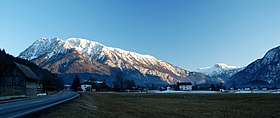Salzkammergut and Upper Austria Alps
| Salzkammergut and Upper Austria Alps | |
|---|---|
| Oberösterreichisch-Salzkammerguter Alpen | |

Hoher Sarstein as seen from Bad Goisern
|
|
| Highest point | |
| Peak | Hoher Dachstein |
| Elevation | 2,995 m (9,826 ft) |
| Coordinates | 47°28′32″N 13°36′23″E / 47.47556°N 13.60639°ECoordinates: 47°28′32″N 13°36′23″E / 47.47556°N 13.60639°E |
| Geography | |
| Country | Austria |
| States of Austria | Upper Austria, Salzburg and Styria |
| Parent range | Alps |
| Borders on | Northern Salzburg Alps, Northern Styrian Alps, Northern Lower Austria Alps and Eastern Tauern Alps |
| Geology | |
| Orogeny | Alpine orogeny |
| Type of rock | Sedimentary rocks |
The Salzkammergut and Upper Austria Alps (Oberösterreichisch-Salzkammerguter Alpen in German) is the proposed name for a subdivision of mountains in a new classification of the Alps, which are located in Austria.
Salzkammergut is the name of a historical territory and literally means Estate of the Salt Chamber; it derives from the Imperial Salt Chamber, the authority charged with running the precious salt mines in the Habsburg empire.
Administratively the range belongs to the Austrian state of Upper Austria, Salzburg and, marginally, to Styria. The whole range is drained by the Danube river.
According to SOIUSA (International Standardized Mountain Subdivision of the Alps) the mountain range is an Alpine section, classified in the following way:
The range is divided into four Alpine subsections:
Some notable summits of the range are:
...
Wikipedia

